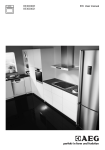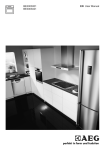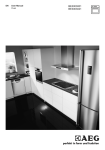Download AEG BE3003021 User manual
Transcript
BE3003021 EN OVEN USER MANUAL 2 FOR PERFECT RESULTS Thank you for choosing this AEG product. We have created it to give you impeccable performance for many years, with innovative technologies that help make life simpler – features you might not find on ordinary appliances. Please spend a few minutes reading to get the very best from it. ACCESSORIES AND CONSUMABLES In the AEG webshop, you’ll find everything you need to keep all your AEG appliances looking spotless and working perfectly. Along with a wide range of accessories designed and built to the high quality standards you would expect, from specialist cookware to cutlery baskets, from bottle holders to delicate laundry bags… Visit the webshop at: www.aeg.com/shop Contents 3 CONTENTS 4 7 8 9 10 11 13 13 23 26 27 30 31 Safety information Product description Before first use Daily use Clock functions Using the accessories Additional functions Helpful hints and tips Care and cleaning What to do if… Installation Environment concerns GREAT BRITAIN & IRELAND Guarantee/Customer Service The following symbols are used in this user manual: Important information concerning your personal safety and information on how to avoid damaging the appliance. General information and tips Environmental information Subject to change without notice. 4 Safety information SAFETY INFORMATION Before the installation and use of the appliance, carefully read the supplied instructions. The manufacturer is not responsible if an incorrect installation and use causes injuries and damages. Always keep the instructions with the appliance for future reference. Children and vulnerable people safety WARNING! Risk of suffocation, injury or permanent disability. • Do not let persons, children included, with reduced physical sensory, reduced mental functions or lack of experience and knowledge use the appliance. They must have supervision or instruction for the operation of the appliance by a person who is responsible for their safety. • Do not let children play with the appliance. • Keep all packaging away from children. • Keep children and pets away from the appliance when it operates or when it cools down. Accessible parts are hot. • If the appliance has a child safety device, we recommend that you activate it. Installation WARNING! Only a qualified person must install this appliance. • • • • • • • • Remove all the packaging. Do not install or use a damaged appliance. Obey the installation instruction supplied with the appliance. Always be careful when you move the appliance because it is heavy. Always wear safety gloves. Do not pull the appliance by the handle. Keep the minimum distance from the other appliances and units. Make sure that the appliance is installed below and adjacent safe structures. The sides of the appliance must stay adjacent to appliances or to units with the same height. Electrical connection WARNING! Risk of fire and electrical shock. • All electrical connections should be made by a qualified electrician. • The appliance must be earthed. • Make sure that the electrical information on the rating plate agrees with the power supply. If not, contact an electrician. • Always use a correctly installed shockproof socket. Safety information 5 • Do not use multi-plug adapters and extension cables. • Make sure not to cause damage to the mains plug and to the mains cable. Contact the Service or an electrician to change a damaged mains cable. • Do not let mains cables to come in touch with the appliance door, specially when the door is hot. • The shock protection of live and insulated parts must be fastened in such a way that it cannot be removed without tools. • Connect the mains plug to the mains socket only at the end of the installation. Make sure that there is access to the mains plug after the installation. • If the mains socket is loose, do not connect the mains plug. • Do not pull the mains cable to disconnect the appliance. Always pull the mains plug. • Use only correct isolation devices: line protecting cut-outs, fuses (screw type fuses removed from the holder), earth leakage trips and contactors. • The electrical installation must have an isolation device which lets you disconnect the appliance from the mains at all poles. The isolation device must have a contact opening width of minimum 3 mm. Use WARNING! Risk of injury, burns or electric shock or explosion. • • • • • • • • • • • • • • Use this appliance in a household environment. Do not change the specification of this appliance. Make sure that the ventilation openings are not blocked. Do not let the appliance stay unattended during operation. Deactivate the appliance after each use. Internally the appliance becomes hot when in operation. Do not touch the heating elements that are in the appliance. Always use oven gloves to remove or put in accessories or ovenware. Be careful, when you open the appliance door while the appliance is in operation. Hot air can release. Do not operate the appliance with wet hands or when it has contact with water. Do not apply pressure on the open door. Do not use the appliance as a work surface or as a storage surface. Always keep the appliance door closed when the appliance is in operation. Open the appliance door carefully. The use of ingredients with alcohol can cause a mixture of alcohol and air. Do not let sparks or open flames to come in contact with the appliance when you open the door. Do not put flammable products or items that are wet with flammable products in, near or on the appliance. WARNING! Risk of damage to the appliance. 6 Safety information • To prevent damage or discoloration to the enamel: – Do not put ovenware or other objects in the appliance directly on the bottom. – Do not put aluminium foil directly on the bottom of the appliance. – do not put water directly into the hot appliance. – do not keep moist dishes and food in the appliance after you finish the cooking. – be careful when you remove or install the accessories. • Discoloration of the enamel has no effect on the performance of the appliance. It is not a defect in the sense of the warranty law. • Use a deep pan for moist cakes. Fruit juices cause stains that can be permanent. Care and Cleaning WARNING! Risk of injury, fire or damage to the appliance. • Before maintenance, deactivate the appliance and disconnect the mains plug from the mains socket. • Make sure the appliance is cold. There is the risk that the glass panels can break. • Replace immediately the door glass panels when they are damaged. Contact the Service. • Be careful when you remove the door from the appliance. The door is heavy! • Clean regularly the appliance to prevent the deterioration of the surface material. • Remaining fat or food in the appliance can cause fire. • Clean the appliance with a moist soft cloth. Only use neutral detergents. Do not use abrasive products, abrasive cleaning pads, solvents or metal objects. • If you use an oven spray, obey the safety instructions on the packaging. • Do not clean the catalytic enamel (if applicable) with any kind of detergent. Internal light • The type of light bulb or halogen lamp used for this appliance, is only for household appliances. Do not use it for house lighting. WARNING! Risk of electrical shock. • Before replacing the lamp, disconnect the appliance from the power supply. • Only use lamps with the same specifications. Disposal WARNING! Risk of injury or suffocation. • Disconnect the appliance from the mains supply. • Cut off the mains cable and discard it. • Remove the door catch to prevent children and pets to get closed in the appliance. Product description PRODUCT DESCRIPTION General overview 2 3 4 5 6 1 7 8 5 4 13 3 9 2 1 10 11 12 1 2 3 4 5 6 7 8 9 10 11 12 13 Control panel Control knob for oven functions Power lamp/symbol Electronic programmer Control knob for temperature Temperature lamp/symbol/indicator Heating element Oven lamp Fan Rear wall heating element Bottom heat Shelf support, removable Shelf positions 7 8 Before first use Accessories • Nonstick wire shelf For cookware, cake tins, roasts. • Grill / roasting pan To bake and roast or as pan to collect fat. • Trivet For roasting and grilling. Use the trivet only with the grill/roasting pan. BEFORE FIRST USE WARNING! Refer to "Safety information" chapter. Initial Cleaning • Remove all parts from the appliance. • Clean the appliance before first use. Refer to chapter "Care and Cleaning". Setting the time The oven only operates after time set. Daily use 9 When you connect the appliance to the electrical supply or in case of a power cut, the Time function indicator flashes automatically. To set the current time use " + " or " - " button. After approximately 5 seconds, the flashing stops and the display shows the time of day set. For time change you must not set an automatic ) at the same function (Duration or End time. DAILY USE WARNING! Refer to "Safety information" chapter. To use the appliance, press the control knob. The control knob comes out. Activating and deactivating the appliance 1. 2. 3. Turn the control knob for the oven functions to select an oven function. Turn the control knob for the temperature to select a temperature. To deactivate the appliance turn the control knobs for the oven functions and temperature to off position. Knob symbol, indicator or lamp (depends on the model - refer to the appliance overview): • The indicator comes on when the oven heats up. • The lamp comes on when the appliance operates. • The symbol shows whether the knob controls one of the cooking zones, the oven functions or the temperature. Oven Functions Oven function Light True Fan Cooking Pizza Setting Conventional Cooking Bottom Heat Application Use this function to light up the oven interior. To bake maximum on three oven levels at the same time. Decrease the oven temperatures (20-40 °C) compared with Conventional. And to dry food. To bake on one oven level food with a more intensive browning and a crispy base. Decrease the oven temperatures (20-40 °C) compared with Conventional To bake and roast on one oven level. To bake cakes with crispy or crusty bases and to preserve food 10 Clock functions Oven function Application Defrost To defrost frozen food. Grilling To grill flat food in the middle of the grill and to toast. Fast Grilling Turbo Grilling To grill flat food in large quantities and to toast. To roast larger joints of meat or poultry on one level. Also for browning food e.g. gratin. Electronic programmer 1 2 3 4 5 6 Function indicators Function indicators Time display Button "+" Selection button Button "-" 1 2 6 3 5 2 4 CLOCK FUNCTIONS Clock function Time of day Minute minder Application Shows the time. To set, change or check the time. To set a countdown time. A signal sounds, after the time period is completed. This function has no effect on the operation of the oven. Duration To set how long the oven has to be in operation. End To set the switch-off time for an oven function. Duration and End can be used at the same time, if the oven is to be switched on and off automatically later. In this case first set Duration , then End . Setting the clock functions 1. Set an oven function and temperature (necessary only for Duration and End). Using the accessories 2. 3. Push the Selection button again and again until necessary function indicator flashes. To set the time for Minute minder , Duration or End , use "+" or "-" button. The related function indicator comes on. When the time period is completed, the function indicator flashes and an acoustic signal sounds for 2 minutes. With the functions Duration 4. 5. 11 and End the oven stops automatically. Push any button to stop the signal. Turn the oven functions control knob and the temperature control knob to off position. Cancelling the clock functions 1. 2. Push the Selection button again and again until necessary function indicator flashes. Push and hold button "- ". After some seconds the clock function goes out. USING THE ACCESSORIES WARNING! Refer to "Safety information" chapter. Installing the Oven Accessories The deep pan and the wire shelf have side edges. These edges and the shape of the guide-bars causes the anti-tilt safety for the oven accessories. 12 Using the accessories Installing the wire shelf and the deep pan together Put the wire shelf on the deep pan. Push the deep pan between the guide-bars of one of the oven levels. Trivet and grill/roasting pan WARNING! Risk of burns when removing the accessories from a hot oven. You can use the trivet to roast larger pieces of meat or poultry on one level: • Put the trivet inside the deep pan so that the supports of the oven shelf point up. • Put the deep pan in the oven at the necessary level. You can use the trivet to grill flat dishes in large quantities and to toast: • Put the trivet inside the deep pan so that the supports of the oven shelf point downwards. • Put the deep pan in the oven at the necessary level. Additional functions 13 ADDITIONAL FUNCTIONS Cooling fan When the appliance operates, the cooling fan activates automatically to keep the surfaces of the appliance cool. If you deactivate the appliance, the cooling fan can continue to operate until the appliance cools down. HELPFUL HINTS AND TIPS Inner side of door In some models on the inner side of the door you can find: • the numbers of the shelf positions (selected models) • information about the heating functions, recommended shelf positions and temperatures for typical dishes (selected models). The temperature and baking times in the tables are guidelines only. They depend on the recipes, quality and quantity of the ingredients used. Baking General instructions • Your new oven may bake or roast differently to the appliance you had before. Adapt your usual settings (temperature, cooking times) and shelf positions to the values in the tables. • With longer baking times, the oven can be switched off about 10 minutes before the end of baking time, to use the residual heat. When you use frozen food, the trays in the oven can twist during baking. When the trays get cold again, the distortion will be gone. How to use the Baking Tables • We recommend to use the lower temperature the first time. • If you cannot find the settings for a special recipe, look for the one that is almost the same. • Baking time can be extended by 10 - 15 minutes, if you bake cakes on more than one level. • Cakes and pastries at different heights do not always brown equally at first. If this occurs, do not change the temperature setting. The differences equalize during the baking procedure. Baking on one level: Baking in tins Type of baking Oven function Shelf position Temperature °C Time in min. Ring cake or brioche True Fan Cooking 1 150 - 160 50 - 70 14 Helpful hints and tips Type of baking Oven function Shelf position Temperature °C Time in min. Madeira cake / fruit cakes True Fan Cooking 1 140 - 160 70 - 90 Fatless sponge cake / Fatless sponge cake True Fan Cooking 2 140 - 150 35 - 50 Fatless sponge cake / Fatless sponge cake Conventional Cooking 2 160 35 - 50 Flan base - short pastry True Fan Cooking 2 170 - 180 1) 10 - 25 Flan base sponge mixture True Fan Cooking 2 150 - 170 20 - 25 Apple pie / Apple pie (2 tins Ø20 cm, diagonally off set) True Fan Cooking 2 160 60 - 90 Apple pie / Apple pie (2 tins Ø20 cm, diagonally off set) Conventional Cooking 1 180 70 - 90 Cheesecake Conventional Cooking 1 170 - 190 60 - 90 Oven function Shelf position Temperature °C Time in min. Plaited bread / bread crown Conventional Cooking 3 170 - 190 30 - 40 Christmas stollen Conventional Cooking 2 160 - 180 1) 50 - 70 Bread (rye bread): 1. First part of baking process. 2. Second part of baking process. Conventional Cooking 1 Cream puffs / eclairs Conventional Cooking 3 190 - 210 1) 20 - 35 Swiss roll Conventional Cooking 3 180 - 200 1) 10 - 20 1) Preheat the oven Cakes / pastries / breads on baking trays Type of baking 1. 2. 2301) 160 - 180 1. 2. 20 30 - 60 Helpful hints and tips 15 Type of baking Oven function Shelf position Temperature °C Time in min. Cake with crumble topping (dry) True Fan Cooking 3 150 - 160 20 - 40 Buttered almond cake / sugar cakes Conventional Cooking 3 190 - 210 1) 20 - 30 Fruit flans (made with yeast dough / sponge mixture) 2) True Fan Cooking 3 150 35 - 55 Fruit flans (made with yeast dough / sponge mixture) 2) Conventional Cooking 3 170 35 - 55 Fruit flans made with short pastry True Fan Cooking 3 160 - 170 40 - 80 Yeast cakes with delicate toppings (e.g, quark, cream, custard) Conventional Cooking 3 160 - 180 1) 40 - 80 Type of baking Oven function Shelf position Temperature °C Time in min. Short pastry biscuits True Fan Cooking 3 150 - 160 10 - 20 Short bread / Short bread / Pastry Stripes True Fan Cooking 3 140 20 - 35 Short bread / Short bread / Pastry Stripes Conventional Cooking 3 160 1) 20 - 30 Biscuits made with sponge mixture True Fan Cooking 3 150 - 160 15 - 20 Pastries made with egg white, merungues True Fan Cooking 3 80 - 100 120 - 150 Macaroons True Fan Cooking 3 100 - 120 30 - 50 Biscuits made with yeast dough True Fan Cooking 3 150 - 160 20 - 40 Puff pastries True Fan Cooking 3 170 - 1801) 20 - 30 Rolls True Fan Cooking 3 1601) 10 - 25 1) Preheat the oven 2) Use deep pan Biscuits 16 Helpful hints and tips Type of baking Oven function Shelf position Temperature °C Time in min. Conventional Cooking 3 190 - 2101) 10 - 25 Small cakes / Small cakes (20 per tray) True Fan Cooking 3 1501) 20 - 35 Small cakes / Small cakes (20 per tray) Conventional Cooking 3 1701) 20 - 30 Temperature in °C Time in min. Rolls 1) Preheat the oven Multileveled Baking Cakes / pastries / breads on baking trays True Fan Cooking Type of baking Shelf position 2 levels 3 levels Cream puffs / eclairs 1/4 - 160 - 180 1) 25 - 45 Dry streusel cake 1/4 - 150 - 160 30 - 45 Temperature in °C Time in min. 1) Preheat the oven Biscuits / small cakes / small cakes / pastries / rolls True Fan Cooking Type of baking Shelf position 2 levels 3 levels Short pastry biscuits 1/4 1/3/5 150 - 160 20 - 40 Short bread / Short bread / Pastry Stripes 1/4 1/3/5 140 25 - 50 Biscuits made with sponge mixture 1/4 - 160 - 170 25 - 40 Biscuits made with egg white, meringues 1/4 - 80 - 100 130 - 170 Macaroons 1/4 - 100 - 120 40 - 80 Biscuits made with yeast dough 1/4 - 160 - 170 30 - 60 Puff pastries 1/4 - 170 - 180 1) 30 - 50 Rolls 1/4 - 180 30 - 55 Helpful hints and tips True Fan Cooking Type of baking Shelf position 2 levels 3 levels 1/4 - Small cakes / Small cakes (20 per tray) 17 Temperature in °C Time in min. 1501) 25 - 40 1) Preheat the oven Tips on baking Baking results Possible cause Remedy Wrong shelf position. Place the cake lower. The oven temperature is too high. The next time you bake set a slightly lower oven temperature. The cake sinks (becomes soggy, lumpy, streaky). The baking time is too short. Set a longer baking time. Baking times cannot be reduced by setting higher temperatures. The cake sinks (becomes soggy, lumpy, streaky). There is too much liquid in the mixture. Use less liquid. Pay attention to mixing times, especially if you use a mixing machine. The cake is too dry. The oven temperature is too low. The next time you bake set a higher oven temperature. The cake is too dry. The baking time is too long. The next time you bake set a shorter baking time. The cake browns unevenly. The oven temperature is too high and the baking time is too short. Set a lower oven temperature and a longer baking time. The cake browns unevenly. The mixture is unevenly distributed. Spread the mixture evenly on the baking tray. The cake is not ready in the baking time given. The oven temperature is too low. The next time you bake set a slightly higher oven temperature. The cake is not browned enough underneath. The cake sinks (becomes soggy, lumpy, streaky). Bakes and gratins Dish Oven function Shelf position Temperature °C Time in min. Pasta bake Conventional Cooking 1 180 - 200 45 - 60 Lasagne Conventional Cooking 1 180 - 200 25 - 40 Turbo Grilling or True Fan Cooking 1 160 - 170 15 - 30 Vegetables au gratin 1) 18 Helpful hints and tips Dish Oven function Shelf position Temperature °C Time in min. Baguettes topped with melted cheese Turbo Grilling or True Fan Cooking 1 160 - 170 15 - 30 Sweet bakes Conventional Cooking 1 180 - 200 40 - 60 Fish bakes Conventional Cooking 1 180 - 200 30 - 60 Turbo Grilling or True Fan Cooking 1 160 - 170 30 - 60 Stuffed vegetables 1) Pre-heat the oven Roasting Roasting dishes • Use heat-resistant ovenware to roast (please read the instructions of the manufacturer). • Large roasting joints can be roasted directly in the deep pan (if present) or on the wire shelf above the deep pan. • Roast lean meats in a roasting tin with a lid. This will keep the meat more succulent. • All types of meat, that can be browned or have crackling, can be roasted in the roasting tin without the lid. Roasting with Turbo Grilling Beef Quantity Oven function Shelf position Temperature °C Time min. Pot roast 1 - 1.5 kg Conventional Cooking 1 230 120 - 150 Roast beef or fillet: rare per cm. of thickness Turbo Grilling 1 190 - 200 1) 5-6 Roast beef or fillet: medium per cm. of thickness Turbo Grilling 1 180 - 190 1) 6-8 Roast beef or fillet: well done per cm. of thickness Turbo Grilling 1 170 - 180 1) 8 - 10 Type of meat Quantity Oven function Shelf position Temperature °C Time min. Shoulder, neck, ham joint 1 - 1.5 kg Turbo Grilling 1 160 - 180 90 - 120 Chop, spare rib 1 - 1.5 kg Turbo Grilling 1 170 - 180 60 - 90 750 g - 1 kg Turbo Grilling 1 160 - 170 50 - 60 Type of meat 1) Preheat the oven Pork Meat loaf Helpful hints and tips 19 Type of meat Quantity Oven function Shelf position Temperature °C Time min. Porkknuckle (precooked) 750 g - 1 kg Turbo Grilling 1 150 - 170 90 - 120 Time min. Veal Type of meat Quantity Oven function Shelf position Temperature °C Roast veal 1 kg Turbo Grilling 1 160 - 180 90 - 120 Knuckle of veal 1.5 - 2 kg Turbo Grilling 1 160 - 180 120 - 150 Type of meat Quantity Oven function Shelf position Temperature °C Time min. Leg of lamb, roast lamb 1 - 1.5 kg Turbo Grilling 1 150 - 170 100 - 120 Saddle of lamb 1 - 1.5 kg Turbo Grilling 1 160 - 180 40 - 60 Type of meat Quantity Oven function Shelf position Temperature °C Time min. Saddle of hare, leg of hare up to 1 kg Conventional Cooking 1 230 1) 30 - 40 Saddle of venison 1.5 - 2 kg Conventional Cooking 1 210 - 220 35 - 40 Haunch of venison 1.5 - 2 kg Conventional Cooking 1 180 - 200 60 - 90 Quantity Oven function Shelf position Temperature °C Time min. Poultry portions 200 - 250 g each Turbo Grilling 1 200 - 220 30 - 50 Half chicken 400 - 500 g each Turbo Grilling 1 190 - 210 35 - 50 Chicken, poulard 1 - 1.5 kg Turbo Grilling 1 190 - 210 50 - 70 Duck 1.5 - 2 kg Turbo Grilling 1 180 - 200 80 - 100 Goose 3.5 - 5 kg Turbo Grilling 1 160 - 180 120 - 180 Turkey 2.5 - 3.5 kg Turbo Grilling 1 160 - 180 120 - 150 Lamb Game 1) Preheat the oven Poultry Type of meat 20 Helpful hints and tips Type of meat Quantity Oven function Shelf position Temperature °C Time min. Turkey 4 - 6 kg Turbo Grilling 1 140 - 160 150 - 240 Type of meat Quantity Oven function Shelf position Temperature °C Time min. Whole fish 1 - 1.5 kg Conventional Cooking 1 210 - 220 40 - 60 Fish (steamed) Grilling Always grill with the maximum temperature setting. Set the shelf into the shelf position as recommended in the grilling table. Always set the pan to collect the fat into the first shelf position. Grill only flat pieces of meat or fish. Always preheat the empty oven with the grill functions for 5 minutes. CAUTION! Always grill with the oven door closed. Grilling Food to be grilled Shelf position Temperature Roast beef 2 Filet of beef Back of pork Time in min. 1st side 2nd side 210 - 230 30 - 40 30 - 40 3 230 20 - 30 20 - 30 2 210 - 230 30 - 40 30 - 40 Back of veal 2 210 - 230 30 - 40 30 - 40 Back of lamb 3 210 - 230 25 - 35 20 - 25 3/4 210 - 230 15 - 30 15 - 30 Whole Fish, 500 1000 g Fast Grilling Food to be grilled Shelf position Time in min. 1st side 2nd side Burgers / Burgers 4 8 - 10 6-8 Pork fillet 4 10 - 12 6 - 10 Sausages 4 10 - 12 6-8 Fillet steaks, veal steaks 4 7 - 10 6-8 Toast / Toast 1) 5 1-3 1-3 Toast with topping 4 6-8 - 1) Preheat the oven Helpful hints and tips 21 Pizza Setting Shelf position Temperature °C Time Min. Pizza (thin crust) Type of baking 2 200 - 230 1)2) 15 - 20 Pizza (with a lot of topping) 2 180 - 200 20 - 30 Tarts 1 180 - 200 40 - 55 Spinach flan 1 160 - 180 45 - 60 Quiche Lorraine 1 170 - 190 45 - 55 Swiss Flan 1 170 - 190 45 - 55 Apple cake, covered 1 150 - 170 50 - 60 Vegetable pie 1 160 - 180 50 - 60 Unleavened bread 2 230 - 2501) 10 - 20 Puff pastry flan 2 160 - 180 1) 45 - 55 Flammekuchen (Pizzalike dish from Alsace) 2 230 - 2501) 12 - 20 Piroggen (Russian version of calzone) 2 180 - 200 1) 15 - 25 1) Pre-heat the oven 2) Use deep pan Defrosting Remove the food packaging. Put the food on a plate. Do not cover it with a bowl or a plate. This can extend the defrost time. Use the first oven shelf position. The one on the bottom. Dish Defrosting time in min. Further defrosting time in min. Comment Chicken, 1000 g 100 - 140 20 - 30 Place the chicken on an upturned saucer placed on a large plate Turn halfway through Meat, 1000 g 100 - 140 20 - 30 Turn halfway through Meat, 500 g 90 - 120 20 - 30 Turn halfway through Trout, 150 g 25 - 35 10 - 15 - Strawberries, 300 g 30 - 40 10 - 20 - Butter, 250 g 30 - 40 10 - 15 - Cream, 2 x 200 g 80 - 100 10 - 15 Cream can also be whipped when still slightly frozen in places Gateau, 1400 g 60 60 - 22 Helpful hints and tips Preserving - Bottom Heat Things to note: • Use only preserve jars of the same dimensions available on the market. • Do not use jars with twist-off and bayonet type lids, or metal tins. • Use the first shelf from the bottom for this function. • Put no more than six one-litre preserve jars on the baking tray. • Fill the jars up to the same level and close with a clamp. • The jars cannot touch each other. • Put approximately 1 / 2 litre of water into the baking tray to give sufficient moisture in the oven. • When the liquid in the jars starts to simmer (after approx. 35 - 60 minutes with one-litre jars), stop the oven or decrease the temperature to 100°C (see the table). Soft fruit Preserve Temperature in °C Cooking time until simmering in min. Continue to cook at 100°C in mis. Strawberries, blueberries, raspberries, ripe gooseberries 160 - 170 35 - 45 - Temperature in °C Cooking time until simmering in min. Continue to cook at 100°C in min. 160 - 170 35 - 45 10 - 15 Temperature in °C Cooking time until simmering in min. Continue to cook at 100°C in min. Carrots 1) 160 - 170 50 - 60 5 - 10 Cucumbers 160 - 170 50 - 60 - Mixed pickels 160 - 170 50 - 60 5 - 10 Kohlrabi, peas, asparagus 160 - 170 50 - 60 15 - 20 Stone fruit Preserve Pears, guinces, plums Vegetables Preserve 1) Leave standing in oven when switched off Drying - True Fan Cooking Cover the oven shelves with baking parchment. For best results: deactivate the appliance after half the time required. Open the appliance door and let the appliance cool down. After that finish the drying process. Vegetables Food to be dried Beans Shelf position 1 level 2 levels Temperature in °C 3 1/4 60 - 70 Time in hours (Guideline) 6-8 Care and cleaning Shelf position 23 1 level 2 levels Temperature in °C Time in hours (Guideline) Peppers 3 1/4 60 - 70 5-6 Vegetables for sour 3 1/4 60 - 70 5-6 Mushrooms 3 1/4 50 - 60 6-8 Herbs 3 1/4 40 - 50 2-3 Time in hours (Guideline) Food to be dried Fruit Shelf position 1 level 2 levels Temperature in °C Plums 3 1/4 60 - 70 8 - 10 Apricots 3 1/4 60 - 70 8 - 10 Apple slices 3 1/4 60 - 70 6-8 Pears 3 1/4 60 - 70 6-9 Food to be dried Information on acrylamides Important! According to the newest scientific knowledge, if you brown food (specially the one which contains starch), acrylamides can pose a health risk. Thus, we recommend that you cook at the lowest temperatures and do not brown food too much. CARE AND CLEANING WARNING! Refer to "Safety information" chapter. Notes on cleaning: • Clean the front of the appliance with a soft cloth with warm water and cleaning agent. • To clean metal surfaces use a usual cleaning agent. • Clean the appliance interior after each use. Then you can remove dirt more easily and it does not burn on. • Clean stubborn dirt with a special oven cleaner. • Clean all accessories (with a soft cloth with warm water and cleaning agent) after each use and let them dry. • If you have nonstick accessories, do not clean them using an aggressive agents, sharp edged objects or dishwasher. It can cause a damage to the nonstick coating. Shelf support You can remove the shelf support to clean the side walls. 24 Care and cleaning Removing the shelf support 1. Pull the front of the shelf support away from the side wall. 2. Pull the shelf support from the back of the side wall to remove it. To install the shelf support follow the procedure in reverse. Valid with telescopic runners: The retaining pins on the telescopic shelf runners must point to the front! 2 1 Oven lamp WARNING! There is a risk of electrical shock. The oven lamp and the lamp glass cover can be hot. Before you change the oven lamp: • Deactivate the appliance. • Remove the fuses from the fuse box or deactivate the circuit breaker. CAUTION! Put a cloth on the bottom of the interior of the appliance. It prevents damage to the lamp glass cover and the cavity. Replacing the oven lamp: 1. You can find the lamp glass cover at the cavity ceiling. Turn the lamp glass cover counterclockwise to remove it. 2. Clean the glass cover. 3. If necessary, replace the oven lamp with applicable 300 °C heat-resistant oven lamp. Use the same oven lamp type. 4. Install the glass cover. 25 Care and cleaning Ceiling You can fold down the heating element on the ceiling to clean the ceiling easily. WARNING! Before you fold down the heating element, deactivate the appliance. Make sure that the appliance is cold. There is a risk of burns! Folding down the heating element 1. Remove the shelf supports. 2. Hold the heating element with the two hands at the front 3. Pull it forwards against the spring pressure and out along the support on both sides. 4. The heating element folds down. The ceiling is ready to clean. Installing the heating element 1. Install the heating element in opposite sequence. Install the heating element correctly on the two sides above the support on the inner wall of the appliance. 2. Install the shelf supports. Door and glass panels To clean the door, remove it. CAUTION! Be careful when you remove the door from the appliance. The door is heavy! Removing the door 1. Open the door as far as it goes. 2. Fully press clamping levers (A) on the two door hinges. 3. Close the door until the first position (angle approximately 70°). 4. Hold of the door with one hand on each side and pull it away from the at an up angle. A A To install the door follow the procedure in reverse. The number of glass panels if different for the different models. CAUTION! Put the door with the outer side down on a soft and level surface to prevent scratches. 26 What to do if… Removing and cleaning the door glass panels 1. Remove the door. 2. Hold the door trim (B) on the top edge of the door at the two sides and push inwards to release the clip seal. 3. Pull the door trim to the front to remove it. B 4. 5. Hold the door glass panels on their top edge one by one and pull them up out of the guide Clean the door glass panels. To install panels follow the procedure in reverse. Install the smaller panel first, then the larger. WHAT TO DO IF… WARNING! Refer to "Safety information" chapter. Problem Possible cause Remedy The oven does not heat up The oven is not switched on Switch on the oven The oven does not heat up The clock is not set Set the clock The oven does not heat up The necessary settings are not set Control the settings The oven does not heat up The fuse in the fuse box is released Control the fuse. If the fuse is released more than one time, refer to a qualified electrician. The oven lamp does not operate The oven lamp is defective Replace the oven lamp Steam and condensation settle on the food and in the oven cavity You left the dish in the oven for too long Do not leave the dishes in the oven for longer than 15 - 20 minutes after the cooking process ends The display shows “12.00” A power cut Reset the clock If you cannot find a solution to the problem yourself, contact your dealer or the service centre. Installation 27 The necessary data for the service centre is on the rating plate. The rating plate is on the front frame of the appliance cavity. We recommend that you write the data here: Model (MOD.) Product number (PNC) Serial number (S.N.) ......................................... ......................................... ......................................... INSTALLATION WARNING! Refer to "Safety information" chapter. The built-in unit must meet the stability requirements of DIN 68930. min. 3 mm 28 Installation min. 50 mm = = 560 min. 600 548 20 min. ! 546 114 530 min. 30 594 572 579 5 567 594 21 Installation 200 cm2 547 546 114 590 560 min. 20 572 530 min. 594 579 5 590 min. 567 594 21 30 max. R1200 mm 130 140 alternativ 100 H05VV-F H05RR-F min. 1600 mm 29 30 Environment concerns 90º 2x3,5x25 ENVIRONMENT CONCERNS The symbol on the product or on its packaging indicates that this product may not be treated as household waste. Instead it should be taken to the appropriate collection point for the recycling of electrical and electronic equipment. By ensuring this product is disposed of correctly, you will help prevent potential negative consequences for the environment and human health, which could otherwise be caused by inappropriate waste handling of this product. For more detailed information about recycling of this product, please contact your local council, your household waste disposal service or the shop where you purchased the product. Packaging material The packaging material is environmentally-friendly and recyclable. Plastic parts are marked with international abbreviations such as PE, PS, etc. Dispose of the packaging material in the containers provided for this purpose at your local waste management facility. GREAT BRITAIN & IRELAND - Guarantee/Customer Service 31 GREAT BRITAIN & IRELAND - GUARANTEE/CUSTOMER SERVICE GB IE Standard guarantee conditions: We, Electrolux, undertake that if within 12 months of the date of the purchase this Electrolux appliance or any part thereof is proved to be defective by reason only of faulty workmanship or materials, we will, at our option repair or replace the same FREE OF CHARGE for labour, materials or carriage on condition that: • Appliance has been correctly installed and used only on the electricity supply stated on the rating plate. • Appliance has been used for normal domestic purposes only, in accordance with manufacturer's instructions. • Appliance hasn't been serviced, maintained, repaired, taken apart or tampered with by person not authorised by us. • Electrolux Service Force Centre must undertake all service work under this guarantee • Any appliance or defective part replaced shall become the Company's property. • This guarantee is in addition to your statutory and other legal rights. Exclusions • Damage, calls resulting from transport, improper use, neglect, light bulbs, removable parts of glass, plastic. • Costs for calls to put right appliance which is improperly installed, calls to appliances outside United Kingdom. • Appliances found to be in use within a commercial environment, plus those which are subject to rental agreements. • Products of Electrolux manufacturer that are not marketed by Electrolux Service and Spare Parts.Please contact your local Service Force Centre: 08445 616 616(Call will be routed to Service Force Centre covering your postcode area). For address of local Service Force Centre and further information, please visit: www.serviceforce.co.uk Before calling out an engineer, please ensure you have read the details under the heading "What to do if... / Troubleshooting". When you contact the Service Force Centre you will need to give the following details: Your name, address and postcode, your telephone number, clear concise details of the fault, model and serial number of the appliance (found on the rating plate), the purchase date. Please note a valid purchase receipt or guarantee documentation is required for in guarantee service calls. Customer Care.Please contact our Customer Care Department: Electrolux Major Appliances, Addington Way, Luton, Bedfordshire, LU4 9QQ or visit our website at www.electrolux.co.uk Customer Care Department, Tel: (Calls may be recorded for training purposes) Electrolux 08445 613 613 AEG-Electrolux 08445 611 611 Zanussi-Electrolux 08445 612 612 32 For Customer Service in The Republic of Ireland please contact us at the address below: Electrolux Group (Irl) Ltd, Long Mile Road, Dublin 12, Republic of Ireland Tel: +353 (0)1 4090751, Email: [email protected] GB European Guarantee: This appliance is guaranteed by Electrolux in each of the countries listed at the back of this user manual, for the period specified in the appliance guarantee or otherwise by law. If you move from one of these countries to another of the countries listed, the appliance guarantee will move with you subject to the following qualifications:• The appliance guarantee starts from the date you first purchased the appliance which will be evidenced by production of a valid purchase document issued by the seller of the appliance. • The appliance guarantee is for the same period and to the same extent for labour and parts as exists in your new country of residence for this particular model or range of appliances. • The appliance guarantee is personal to the original purchaser of the appliance and cannot be transferred to another user. • The appliance is installed and used in accordance with instructions issued by Electrolux and is only used within the home, i.e. is not used for commercial purposes. • The appliance is installed in accordance with all relevant regulations in force within your new country of residence. The provisions of this European Guarantee do not affect any of the rights granted to you by law. 33 34 35 www.aeg.com/shop 892949400-A-072012
















































